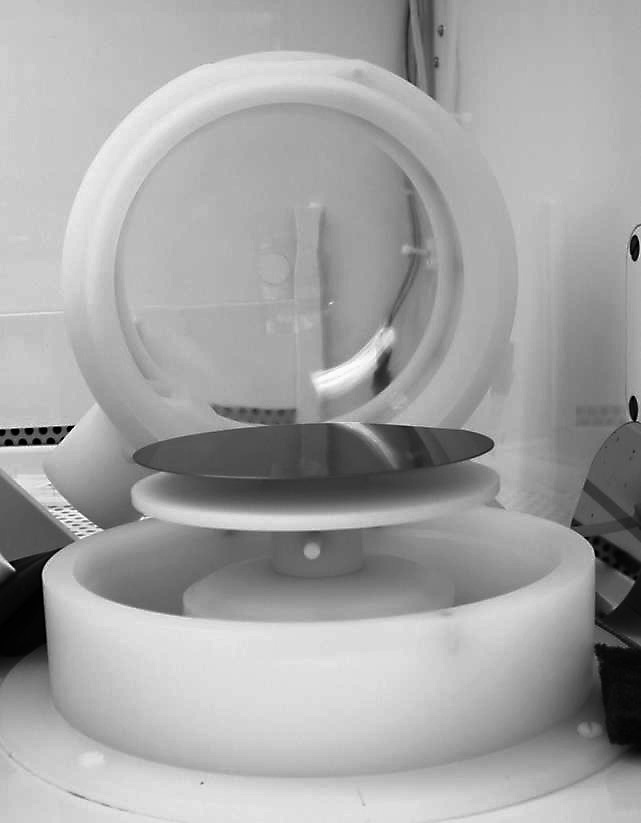spin coating on:
[Wikipedia]
[Google]
[Amazon]
 Spin coating is a procedure used to deposit uniform
Spin coating is a procedure used to deposit uniform
Spin Coating of Thin and Ultrathin Polymer Films
*
Deposition of polymer films by spin casting: A quantitative analysis
Industrial processes Semiconductor device fabrication Thin film deposition {{Industry-stub
 Spin coating is a procedure used to deposit uniform
Spin coating is a procedure used to deposit uniform thin film
A thin film is a layer of materials ranging from fractions of a nanometer ( monolayer) to several micrometers in thickness. The controlled synthesis of materials as thin films (a process referred to as deposition) is a fundamental step in many ...
s onto flat substrates. Usually a small amount of coating material in liquid form is applied on the center of the substrate, which is either spinning at low speed or not spinning at all. The substrate is then rotated at speeds up to 10,000 rpm to spread the coating material by centrifugal force
Centrifugal force is a fictitious force in Newtonian mechanics (also called an "inertial" or "pseudo" force) that appears to act on all objects when viewed in a rotating frame of reference. It appears to be directed radially away from the axi ...
. A machine used for spin coating is called a spin coater, or simply spinner.
Rotation is continued while the fluid spins off the edges of the substrate, until the desired thickness of the film is achieved. The applied solvent is usually volatile, and simultaneously evaporates. The higher the angular speed
In physics, angular frequency (symbol ''ω''), also called angular speed and angular rate, is a scalar measure of the angle rate (the angle per unit time) or the temporal rate of change of the phase argument of a sinusoidal waveform or sine f ...
of spinning, the thinner the film. The thickness of the film also depends on the viscosity
Viscosity is a measure of a fluid's rate-dependent drag (physics), resistance to a change in shape or to movement of its neighboring portions relative to one another. For liquids, it corresponds to the informal concept of ''thickness''; for e ...
and concentration
In chemistry, concentration is the abundance of a constituent divided by the total volume of a mixture. Several types of mathematical description can be distinguished: '' mass concentration'', '' molar concentration'', '' number concentration'', ...
of the solution, and the solvent. Pioneering theoretical analysis of spin coating was undertaken by Emslie et al., and has been extended by many subsequent authors (including Wilson et al., who studied the rate of spreading in spin coating; and Danglad-Flores et al., who found a universal description to predict the deposited film thickness).
Spin coating is widely used in microfabrication
Microfabrication is the process of fabricating miniature structures of micrometre scales and smaller. Historically, the earliest microfabrication processes were used for integrated circuit fabrication, also known as "semiconductor manufacturing" ...
of functional oxide layers on glass or single crystal substrates using sol-gel precursors, where it can be used to create uniform thin films with nanoscale thicknesses. It is used intensively in photolithography
Photolithography (also known as optical lithography) is a process used in the manufacturing of integrated circuits. It involves using light to transfer a pattern onto a substrate, typically a silicon wafer.
The process begins with a photosensiti ...
, to deposit layers of photoresist
A photoresist (also known simply as a resist) is a light-sensitive material used in several processes, such as photolithography and photoengraving, to form a patterned coating on a surface. This process is crucial in the electronics industry.
T ...
about 1 micrometre
The micrometre (English in the Commonwealth of Nations, Commonwealth English as used by the International Bureau of Weights and Measures; SI symbol: μm) or micrometer (American English), also commonly known by the non-SI term micron, is a uni ...
thick. Photoresist is typically spun at 20 to 80 revolutions per second for 30 to 60 seconds. It is also widely used for the fabrication of planar photonic structures made of polymers. Spin-coating is also sometimes used in the preparation of alignment films for LCD displays.
One advantage to spin coating thin films is the uniformity of the film thickness. Owing to self-leveling, thicknesses do not vary more than 1%. The thickness of films produced in this manner may also affect the optical properties of such materials. This is important for electrochemical testing, specifically when recording absorbance readings from Ultraviolet-visible Spectroscopy, since thicker films have lower optical transmittance and typically do not allow light to shine through in comparison to thinner films allowing light to go through before the optical density of the film becomes too low. Additionally, films with lower absorbance quality are not as ideal of candidates for processes such as Cyclic Voltammetry because the low absorbance hinders electrochemical tuning of cations when in an electrochemical cell. Thinner films in this regard have more desirable optical properties that can be tuned for energy storage technologies because of their spin coated influenced properties. However, spin coating thicker films of polymers
A polymer () is a substance or material that consists of very large molecules, or macromolecules, that are constituted by many repeating subunits derived from one or more species of monomers. Due to their broad spectrum of properties, b ...
and photoresists can result in relatively large edge beads whose planarization has physical limits.
References
Further reading
* S. Middleman and A.K. Hochberg. "Process Engineering Analysis in Semiconductor Device Fabrication". McGraw-Hill, p. 313 (1993) *External links
*Spin Coating of Thin and Ultrathin Polymer Films
*
Deposition of polymer films by spin casting: A quantitative analysis
Industrial processes Semiconductor device fabrication Thin film deposition {{Industry-stub